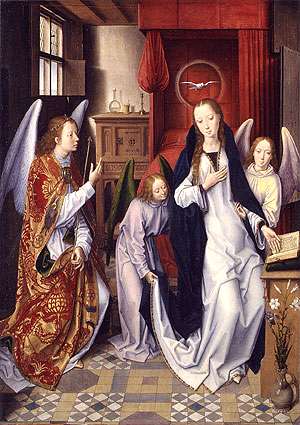
Hans Memling
The Annunciation
1480-1489
Oil on canvas, transferred from wood, 30 x 21⅛ in. (76.2 x 53.6 cm)
Metropolitan Museum of Art, Robert Lehman Collection, 1975.1.113
The artist adopts a number of conventional motifs: the book, the scepter, the vase of lilies, the dove entering on a ray of light through a closed window, and Mary's rounded belly. Also conventional by the end of the 15th century, especially in the north, are the bed and the setting in a bourgeois home.
To this traditional iconography Memling adds the cabinet in the back with a water carafe and a candleholder. The museum's online commentary interprets the empty candleholder to refer to Christ, the "light of the world," and the carafe to be a symbol of Mary's virginity in the sense that light can pass through without changing it.
Two other innovations allude to the Mass. Gabriel wears a bishop's cope, and the attendant angels resemble acolytes. The one on the left lifts the back of Mary's robe, as the acolyte does at the
Elevation
After consecrating the host, the priest lifts it high so all the faithful can see it.
with the back of the priest's chasuble.
Read more about images of the Annunciation.
Photograph: Metropolitan Museum of Art